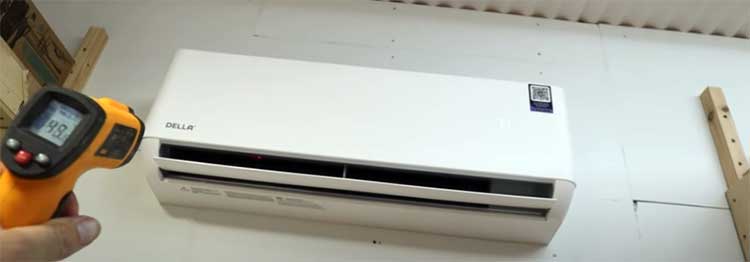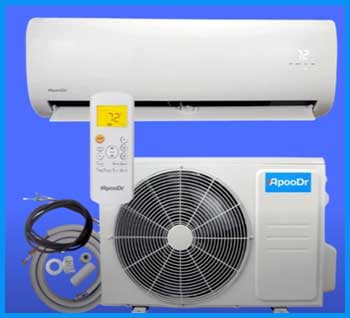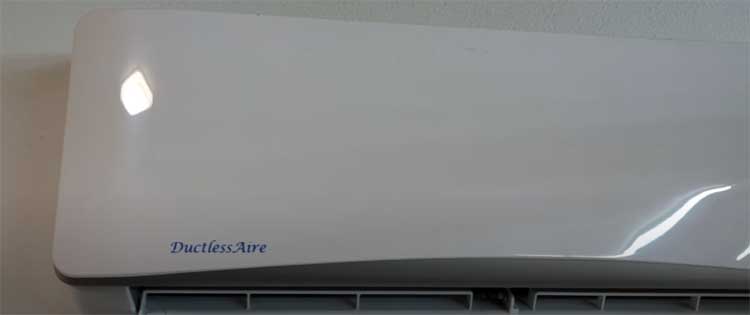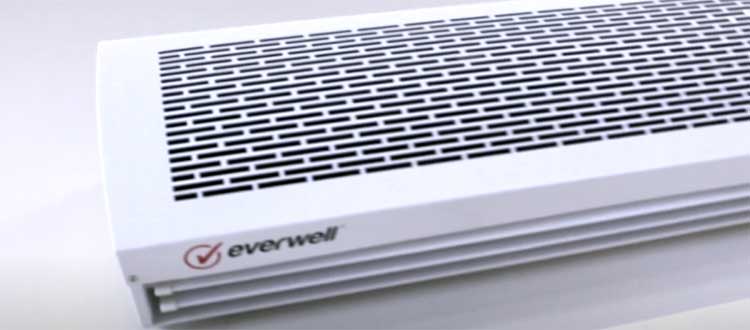I’ll cut to the chase: if you’re hunting for an affordable, efficient way to keep your home cool in summer and warm in winter, a Della mini split is a game-changer.
After sweating through one too many Texas summers and shivering in poorly heated rooms, I decided to take control of my home’s climate. Della’s mini splits deliver reliable performance without breaking the bank, and I’m here to share my experience.
From installation to daily use, these units have transformed my space, and I’m confident they’ll do the same for you. Let’s explore why this is a purchase you won’t regret.
My Journey With The Della Mini Split

A few years ago, my old central AC unit gave up the ghost.
The repair bill was astronomical, and the thought of ductwork upgrades made my wallet weep.
I started researching alternatives and stumbled across mini splits—compact, ductless systems that promised zoned heating and cooling.
After reading reviews and comparing brands, I settled on a Della 12,000 BTU mini split for my 600-square-foot living area.
The price was right, and the promise of DIY-friendly installation sealed the deal.
When the unit arrived, I was nervous but excited. I’m no HVAC pro, but I’m handy enough to follow instructions.
The setup wasn’t a walk in the park, but Della’s manual was clear, and I had it up and running in a weekend. The first blast of cool air felt like a personal victory. Since then, it’s been a reliable companion through scorching summers and chilly winters.
I’ve got it mounted in my living room, and it keeps the space comfortable, even when the Texas sun is relentless. The remote control is a lifesaver—I can tweak the temperature without leaving the couch.
What surprised me most was how quiet it is. My old AC sounded like a jet engine, but the Della hums along discreetly. I’ve also noticed a dip in my energy bills, which was a pleasant shock.
The unit’s inverter technology adjusts power usage to match the room’s needs, so it’s not constantly guzzling electricity. My only hiccup was a minor issue with the remote syncing, but a quick call to customer service sorted it out.
Overall, my Della mini split has been a reliable, budget-friendly solution that’s made my home a haven.
What Makes Della Mini Splits Stand Out?

- Energy Efficiency That Saves You Money
One of the biggest reasons I’m a Della fan is the energy efficiency. These units often boast SEER ratings between 17 and 22, which means they use less electricity to cool or heat your space compared to traditional systems.
My 12,000 BTU unit keeps my living room at a steady 72°F without spiking my power bill. The inverter technology is the secret sauce—it adjusts the compressor speed to match the room’s needs, so you’re not wasting energy.
For someone like me, who cringes at high utility bills, this is a massive win.
- Quiet Operation for Peaceful Living
If you’ve ever lived with a noisy AC, you’ll appreciate Della’s whisper-quiet performance. The indoor unit barely makes a sound, even when it’s working hard. I’ve had friends over who didn’t even realize the unit was running until I pointed it out.
This is a huge plus if you’re using it in a bedroom or a home office where silence is golden. The outdoor unit isn’t silent, but it’s no louder than a standard conversation, and since it’s outside, it’s not disruptive.
- Flexible Installation for Any Space
Della mini splits are ductless, which means you don’t need to tear up your walls for installation. I installed mine in a weekend with basic tools, and the flexibility to place the indoor unit almost anywhere is a lifesaver.
Whether you’re cooling a single room or a small apartment, Della’s compact design fits the bill. The included line set and clear instructions made the process manageable, even for a DIY newbie like me.
- Smart Features for Modern Convenience
I love the techy side of my Della unit. The remote control lets me adjust settings from across the room, and some models come with Wi-Fi connectivity for app-based control.
Being able to tweak the temperature from my phone while I’m still in bed?
Yes, please. The unit also has features like a sleep mode that gradually adjusts the temperature overnight, which keeps me comfortable without wasting energy.
- Affordability Without Sacrificing Quality
Let’s talk money. Della mini splits are priced lower than premium brands like Mitsubishi or Daikin, but they don’t skimp on performance. My unit cost around $600, a fraction of what I’d have paid for a high-end model.
For budget-conscious folks like me, Della offers a sweet spot of affordability and reliability. You get solid performance without the sticker shock, which is why I keep recommending it to friends.
The Downsides of Della Mini Splits
- Limited Warranty Coverage

One thing that gave me pause is Della’s warranty.
It’s typically a 5-year limited warranty on parts and the compressor, which is decent but not as robust as some competitors.
Brands like Daikin offer 12-year warranties, which can feel more reassuring if you’re investing for the long haul.
I haven’t needed warranty service yet, but knowing it’s shorter than others makes me a bit cautious.
You’ll want to register your unit promptly to ensure coverage, and keep in mind that DIY installations might complicate warranty claims.
- Customer Service Can Be Hit-or-Miss
While I had a positive experience with Della’s customer service, I’ve heard mixed stories. When my remote had a syncing issue, a quick call got me a solution, but some users report slow response times or difficulty getting replacement parts.
This isn’t a dealbreaker, but it’s worth noting if you rely on fast support. I’d recommend keeping the manual handy and familiarizing yourself with basic troubleshooting to avoid headaches.
- Not the Best for Extreme Climates
Della mini splits perform well in moderate climates, but they’re not the champs in extreme conditions. My unit handles Texas heat like a pro, but in sub-zero winters, it might struggle to maintain efficiency.
If you live in a place with brutal winters, you might need a unit with advanced low-temperature performance, like Mitsubishi’s Hyper-Heating technology. For most of us, though, Della’s range is more than sufficient.
- Installation Requires Some Skill
While I managed a DIY install, it’s not a breeze for everyone. You’ll need to handle refrigerant lines, drill through walls, and pull a vacuum on the system. If you’re not handy, you might need to hire a pro, which adds to the cost.
I spent a weekend cursing at flare fittings, but the satisfaction of doing it myself was worth it. Just be honest with yourself about your DIY skills before jumping in.
How To Keep Your Della Mini Split Running Smoothly?
- Regular Filter Cleaning
Your Della’s filters are the unsung heroes of clean air, but they get gunked up fast. I clean mine every month by popping them out, rinsing them with warm water, and letting them air dry. It takes 10 minutes and keeps the unit running efficiently.
Dirty filters force the system to work harder, which can hike up your energy bill and strain the compressor. Set a calendar reminder to stay on top of it—you’ll thank yourself later.
- Check the Outdoor Unit for Debris
The outdoor unit is exposed to the elements, so it’s prone to collecting leaves, dirt, or even spider webs. I check mine every couple of months, especially after storms. A quick sweep with a broom or a gentle hose-down keeps it clear.
Make sure the unit has at least two feet of clearance around it for proper airflow. A clogged outdoor unit can reduce efficiency and overheat the system, so don’t skip this step.
- Monitor Refrigerant Levels
Low refrigerant can make your Della struggle to cool or heat. I check for signs like reduced cooling power or frost on the lines. If you suspect a leak, call a pro—handling refrigerant isn’t a DIY job.
My unit came pre-charged, but after a year, I had a tech verify the levels during a routine check. Keeping refrigerant in check ensures your unit runs smoothly and avoids costly repairs.
- Schedule Annual Professional Maintenance
Even if you’re a DIY enthusiast, an annual checkup by an HVAC tech is worth it. They’ll inspect the electrical components, tighten connections, and ensure the system is running at peak performance.
I budget about $100 a year for this, and it’s saved me from potential breakdowns. A pro can spot issues like worn-out parts that you might miss, extending your unit’s lifespan.
- Use the Self-Cleaning Feature Wisely
Many Della models have a self-cleaning mode that helps reduce mold and dust inside the unit. I run mine once a month, but it’s not a substitute for manual cleaning.
Think of it as a helper, not a cure-all. After running the self-clean mode, I still check the filters and vents to make sure everything’s spotless. This keeps the air quality high and prevents musty odors.
How Della Stacks Up Against the Competition?
- ApooDr Mini Split

ApooDr mini splits, often made by Midea, are a close cousin to Della in terms of price and performance.
I looked at a 12,000 BTU ApooDr unit before choosing my Della, and they’re strikingly similar.
Both offer solid SEER ratings around 17-19, and ApooDr’s units are also DIY-friendly.
However, I found ApooDr’s instructions a bit less clear, which could trip up first-timers.
Users on forums praise ApooDr for holding up in cold climates, sometimes down to 5°F, but I’ve noticed Della’s build feels sturdier.
If you’re on a tight budget and don’t mind a slightly trickier setup, ApooDr is a strong contender, but Della’s ease of use gives it an edge for me.
- Mirage Mini Split

Mirage mini splits have a loyal following, especially for tiny homes and small spaces.
With over 25 years in the HVAC game, Mirage brings experience, but I found their units pricier than Della for similar specs.
A 12,000 BTU Mirage unit I considered was about $200 more than my Della, and the efficiency ratings were comparable.
Mirage’s customer service gets better reviews, which is a plus if you value support.
However, their units can be noisier, especially the outdoor compressor, which was a dealbreaker for my quiet neighborhood. Della’s balance of affordability and quiet operation won me over, but Mirage is worth a look if you prioritize brand longevity.
- DuctlessAire Mini Split

DuctlessAire is another budget-friendly option that competes head-to-head with Della. I checked out their 9,000 BTU model, and it’s a solid choice for smaller spaces.
DuctlessAire’s units often hit SEER ratings of 19-20, slightly higher than some Della models, which could save you a few bucks on energy. But their warranty is similar to Della’s—around 5 years—and I’ve read complaints about inconsistent cooling in larger rooms.
My Della handles my 600-square-foot space with ease, and I suspect DuctlessAire might struggle in bigger areas. If you’re cooling a small bedroom, DuctlessAire is a great pick, but Della’s versatility suits my needs better.
- Everwell Mini Split

Everwell caught my eye for its low price, but I quickly learned it’s a risky bet. Users frequently report issues with Everwell’s reliability, like control board failures or leaks after a couple of years. Della isn’t perfect, but I’ve had no major issues in two years of use.
Everwell’s warranty is strict, often requiring a licensed installer to validate it, which defeats the DIY appealbeginner-friendly appeal. Their units also lack some of Della’s smart features, like Wi-Fi control.
If you’re tempted by Everwell’s rock-bottom price, proceed with caution—Della’s slightly higher cost feels justified for the peace of mind and extra features.
Frequently Asked Questions (FAQ)
With proper care, a Della mini split can last 10-15 years. My unit’s been going strong for two years, and regular maintenance like filter cleaning and annual checkups keeps it in top shape. The compressor and parts are built to last, but neglecting upkeep can shorten the lifespan. Stick to a maintenance routine, and your Della should serve you well for over a decade.
Reliability depends on your needs, but Mitsubishi and Daikin often top the charts for premium performance, with warranties up to 12 years. For budget-friendly options, Della and Pioneer hold their own. My Della’s been trouble-free, and user reviews suggest it’s as dependable as pricier brands for moderate climates. If you want high-end durability, Mitsubishi’s a safe bet, but Della’s a solid middle ground.
Pioneer and Della are both budget-friendly, but Pioneer’s units often have slightly higher SEER ratings, around 19-21, compared to Della’s 17-22. I chose Della for its clearer installation guide and quieter operation. Pioneer’s warranty is similar, but their customer service gets better marks. Both are great for DIYers, but Della’s smart features, like Wi-Fi control, tipped the scales for me.
Mini splits, including Della, aren’t perfect. Installation can be tricky if you’re not handy, and professional setup adds cost. They’re less effective in extreme cold, so if you’re in a harsh winter climate, you might need a backup heater. Maintenance, like cleaning filters, is a must to avoid efficiency drops. Finally, warranties on budget brands like Della are shorter than premium options, which might concern long-term planners.
Wrapping It Up: Why Della’s Worth Your Money?
After two years with my Della mini split, I’m still thrilled with my choice. It’s affordable, efficient, and keeps my home comfortable year-round. From its quiet hum to its energy-saving tech, it’s a purchase that delivers.
Whether you’re a DIYer or just want a reliable cooling and heating solution, Della’s got you covered. Don’t let another sweaty summer or chilly winter catch you off guard—grab a Della mini split and take control of your comfort today.
